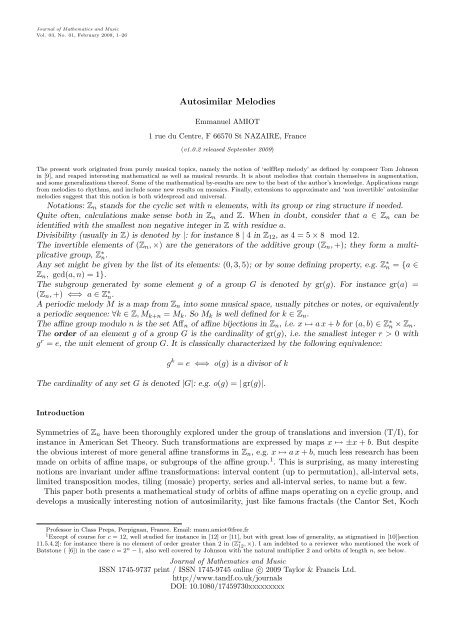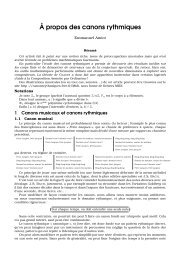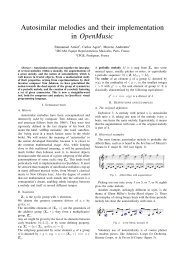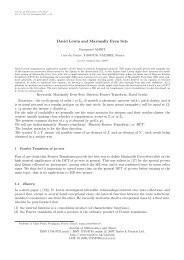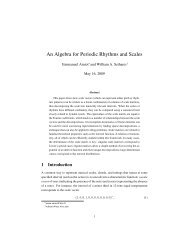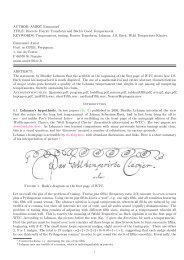Emmanuel Amiot Modèles algébriques et algorithmes pour la ...
Emmanuel Amiot Modèles algébriques et algorithmes pour la ...
Emmanuel Amiot Modèles algébriques et algorithmes pour la ...
You also want an ePaper? Increase the reach of your titles
YUMPU automatically turns print PDFs into web optimized ePapers that Google loves.
Journal of Mathematics and Music<br />
Vol. 03, No. 01, February 2009, 1–26<br />
Autosimi<strong>la</strong>r Melodies<br />
<strong>Emmanuel</strong> AMIOT<br />
1 rue du Centre, F 66570 St NAZAIRE, France<br />
(v1.0.2 released September 2009)<br />
The present work originated from purely musical topics, namely the notion of ‘selfRep melody’ as defined by composer Tom Johnson<br />
in [9], and reaped interesting mathematical as well as musical rewards. It is about melodies that contain themselves in augmentation,<br />
and some generalizations thereof. Some of the mathematical by-results are new to the best of the author’s knowledge. Applications range<br />
from melodies to rhythms, and include some new results on mosaics. Finally, extensions to approximate and ‘non invertible’ autosimi<strong>la</strong>r<br />
melodies suggest that this notion is both widespread and universal.<br />
Notations: Zn stands for the cyclic s<strong>et</strong> with n elements, with its group or ring structure if needed.<br />
Quite often, calcu<strong>la</strong>tions make sense both in Zn and Z. When in doubt, consider that a ∈ Zn can be<br />
identified with the smallest non negative integer in Z with residue a.<br />
Divisibility (usually in Z) is denoted by |: for instance 8 | 4 in Z12, as 4 = 5 × 8 mod 12.<br />
The invertible elements of (Zn, ×) are the generators of the additive group (Zn, +); they form a multiplicative<br />
group, Z ∗ n.<br />
Any s<strong>et</strong> might be given by the list of its elements: (0, 3, 5); or by some defining property, e.g. Z ∗ n = {a ∈<br />
Zn, gcd(a, n) = 1}.<br />
The subgroup generated by some element g of a group G is denoted by gr(g). For instance gr(a) =<br />
(Zn, +) ⇐⇒ a ∈ Z ∗ n.<br />
A periodic melody M is a map from Zn into some musical space, usually pitches or notes, or equivalently<br />
a periodic sequence: ∀k ∈ Z, Mk+n = Mk. So Mk is well defined for k ∈ Zn.<br />
The affine group modulo n is the s<strong>et</strong> Affn of affine bijections in Zn, i.e. x ↦→ a x + b for (a, b) ∈ Z ∗ n × Zn.<br />
The order of an element g of a group G is the cardinality of gr(g), i.e. the smallest integer r > 0 with<br />
g r = e, the unit element of group G. It is c<strong>la</strong>ssically characterized by the following equivalence:<br />
g k = e ⇐⇒ o(g) is a divisor of k<br />
The cardinality of any s<strong>et</strong> G is denoted |G|: e.g. o(g) = | gr(g)|.<br />
Introduction<br />
Symm<strong>et</strong>ries of Zn have been thoroughly explored under the group of trans<strong>la</strong>tions and inversion (T/I), for<br />
instance in American S<strong>et</strong> Theory. Such transformations are expressed by maps x ↦→ ±x + b. But despite<br />
the obvious interest of more general affine transforms in Zn, e.g. x ↦→ a x + b, much less research has been<br />
made on orbits of affine maps, or subgroups of the affine group. 1 . This is surprising, as many interesting<br />
notions are invariant under affine transformations: interval content (up to permutation), all-interval s<strong>et</strong>s,<br />
limited transposition modes, tiling (mosaic) property, series and all-interval series, to name but a few.<br />
This paper both presents a mathematical study of orbits of affine maps operating on a cyclic group, and<br />
develops a musically interesting notion of autosimi<strong>la</strong>rity, just like famous fractals (the Cantor S<strong>et</strong>, Koch<br />
Professor in C<strong>la</strong>ss Preps, Perpignan, France. Email: manu.amiot@free.fr<br />
1Except of course for c = 12, well studied for instance in [12] or [11], but with great loss of generality, as stigmatised in [10][section<br />
11.5.4.2]: for instance there is no element of order greater than 2 in (Z∗ 12 , ×). I am indebted to a reviewer who mentioned the work of<br />
Batstone ( [6]) in the case c = 2n − 1, also well covered by Johnson with the natural multiplier 2 and orbits of length n, see below.<br />
Journal of Mathematics and Music<br />
ISSN 1745-9737 print / ISSN 1745-9745 online c○ 2009 Taylor & Francis Ltd.<br />
http://www.tandf.co.uk/journals<br />
DOI: 10.1080/17459730xxxxxxxxx


